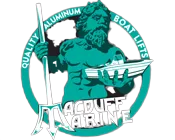A Brief History of Floating Docks
The concept of floating docks has been around for decades, but early versions were often rudimentary—basic wooden platforms supported by barrels or other buoyant materials. While functional, these early designs lacked durability, flexibility, and the ability to adapt to changing waterfront needs.
As waterfront living became more popular, the demand for better dock solutions grew. This led to advancements in materials, construction methods, and modular designs, transforming floating docks into the highly engineered systems we see today.
Key Advancements in Floating Dock Technology
- High-Density Materials:
Modern floating docks are constructed using high-density polyethylene or similar materials that resist UV damage, saltwater corrosion, and general wear and tear. This has significantly increased their lifespan compared to older wooden or metal docks. - Modular Design
Early docks were fixed in size and structure, but today’s floating docks are modular, allowing property owners to customize and expand their setups to suit changing needs. - Improved Buoyancy and Stability
Advanced engineering has resulted in floating docks that provide exceptional buoyancy and stability, even under heavy loads or rough water conditions. - Aesthetic Options
Gone are the days of plain, utilitarian docks. Modern floating docks, like those from WaveArmor, combine functionality with sleek, stylish designs that enhance the overall look of your waterfront.
When it comes to leading the floating dock revolution, WaveArmor is at the forefront. Here’s what makes them stand out:
- Premium Materials for Maximum Durability:
WaveArmor docks are built from rotationally molded polyethylene, offering superior strength and resistance to the elements. - True Modular Flexibility:
Whether you want a simple dock or a full-scale waterfront system, WaveArmor’s modular design lets you build and expand your dock to meet your exact needs. - Integrated Accessories:
WaveArmor offers a range of add-ons, from jet ski ports to fishing rod holders, that integrate seamlessly into the dock system. - Eco-Friendly Design:
WaveArmor docks are designed with minimal environmental impact, ensuring your waterfront remains pristine.
Why WaveArmor is the Future of Floating Docks
WaveArmor doesn’t just follow trends—it sets them. Their commitment to innovation has resulted in docks that are not only practical but also a pleasure to own. Here’s why they’re leading the way:
- Ease of Use: WaveArmor docks are designed for effortless assembly, installation, and maintenance.
- Customizable Features: The ability to tailor your dock with WaveArmor’s extensive range of accessories ensures it fits your lifestyle perfectly.
- Unmatched Longevity: Thanks to their durable construction, WaveArmor docks maintain their functionality and appearance for years, even in challenging environments like South Florida.
FAQs About Floating Dock Advancements
- What materials are WaveArmor docks made of?
WaveArmor docks are constructed from rotationally molded polyethylene, making them resistant to UV rays, saltwater, and impact damage. - How are modern floating docks anchored?
WaveArmor docks use advanced anchoring systems designed to keep the dock secure in a variety of water conditions, including strong currents and tidal changes. - Can I customize my WaveArmor dock?
Yes! WaveArmor’s modular design allows you to add sections, change configurations, and include accessories like kayak racks, jet ski ports, and dock benches. - Are floating docks environmentally friendly?
Yes, floating docks are designed with eco-friendly materials and installation methods, minimizing their impact on marine ecosystems.
WaveArmor docks are designed with eco-friendly materials and installation methods, minimizing their impact on marine ecosystems.
